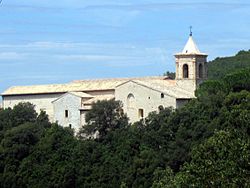History
The abbey was founded by the Benedictines around 1070, probably by one Mainhard coming from Santa Maria di Sitria. The abbey was based on an existing castle of the Monaldi family, on a site probably used in ancient times by the Umbri as sanctuary.
The abbey soon increased its power and prestige thanks to numerous donations. In 1138 its possession extended from Rome (the basilica of Santi Quattro Coronati) to Perugia, Spoleto and Camerino. In the following centuries it had 97 monasteries, 41 churches and 7 hospitals. In the late 15th century the abbey passed to the Olivetan Benedictines.
The abbey started to decay from the 15th century. In the course of the Napoleonic Wars, it was partially closed and in 1860, after the fall of the Papal States, its dependencies were divided between the Italian state, the local bishopric and privates. Today, part of the Abbey belongs to the Diocese of Foligno, another part to the State and the third part to a private family.
In 1979, the Bishop of Foligno entrusted the abbey to the community of the Little Brothers of Jesus Caritas who continue to live there. [2]
In the 1970s-1990s a substantial program of restoration was carried on. The church is still under restoration after having been damaged by an earthquake in 1997.
This page is based on this
Wikipedia article Text is available under the
CC BY-SA 4.0 license; additional terms may apply.
Images, videos and audio are available under their respective licenses.


